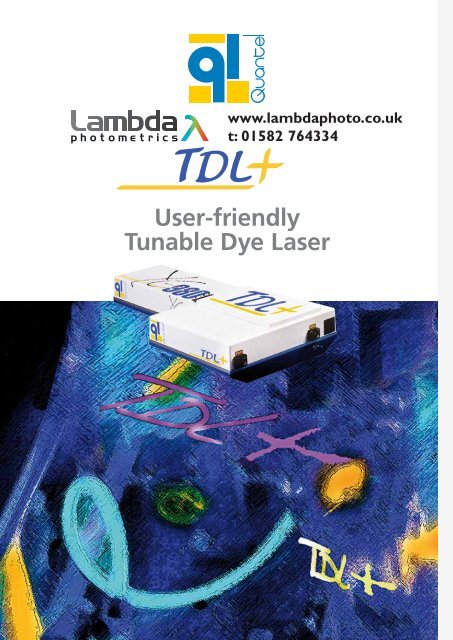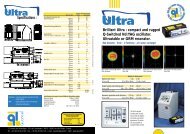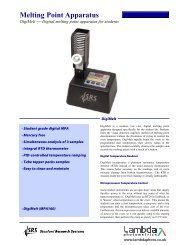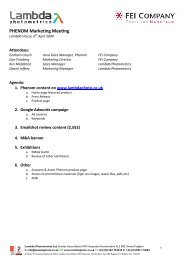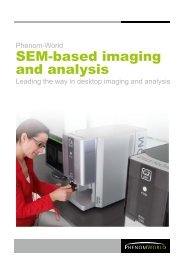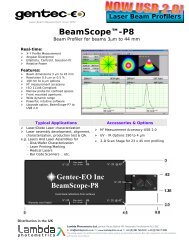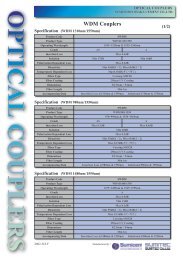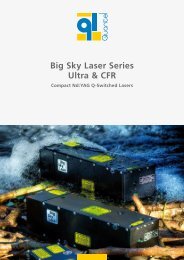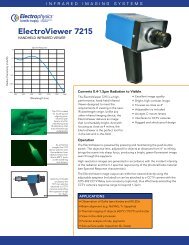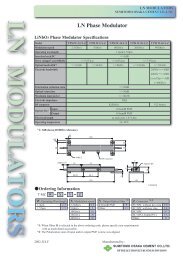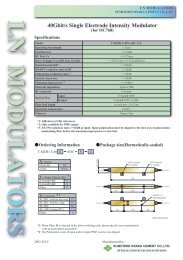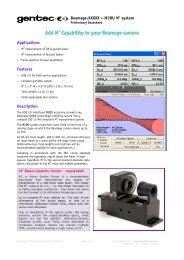User-friendly Tunable Dye Laser - Lambda Photometrics
User-friendly Tunable Dye Laser - Lambda Photometrics
User-friendly Tunable Dye Laser - Lambda Photometrics
You also want an ePaper? Increase the reach of your titles
YUMPU automatically turns print PDFs into web optimized ePapers that Google loves.
<strong>User</strong>-<strong>friendly</strong><br />
<strong>Tunable</strong> <strong>Dye</strong> <strong>Laser</strong>
TDL+ ADVANTAGES<br />
Wide tunability:<br />
Two gratings allow for coverage of the 200- 4500nm range<br />
without realignment of the cavity. Unique dual grating option<br />
enables configuration without direct handling of the grating<br />
assemblies.<br />
5<br />
3<br />
Spectral access - UV and IR generations:<br />
Nonlinear crystals provide options for motorized or automatic<br />
phase-matching and beam compensation.<br />
Excellent passive and active stability:<br />
Passive stability is achieved through integrated design on<br />
option benches - Active stability is achieved by closed loop<br />
temperature control of both the oscillator spectral<br />
cavity and nonlinear crystals.<br />
1<br />
2<br />
4<br />
6<br />
Easy dye exchange:<br />
<strong>Dye</strong> exchange without removing dye cells prevents<br />
misalignment.<br />
Quantel support and service:<br />
Quantel’s long history in design and manufacture of TDL<br />
tunable solutions means your productivity is backed by<br />
industry experts in installation, integration, support, and<br />
field service.<br />
Simplicity and user safety:<br />
• Automatic recognition of the frequency conversion<br />
crystals in IR and UV.<br />
• Phase-matching tracking easy to use<br />
• Dedicated software controls both pumping and dye lasers.<br />
• Optimization and dye exchange in user operation<br />
configuration without opening the housing.<br />
1<br />
2<br />
3<br />
4<br />
5<br />
6<br />
Oscillator<br />
Pre amplifier<br />
Amplifier<br />
Pumping beam<br />
Fundamental beam<br />
1064nm beam for UV mixing<br />
TDL+ remote module<br />
Courtesy : CLUPS (Orsay – France)<br />
Crystals and IR/UV<br />
options accessories
TDL+: PERFORMANCE, RELIABILITY, FLEXIBILITY<br />
AND USER-FRIENDLY PULSED, TUNABLE DYE LASER SOLUTION<br />
<strong>Tunable</strong> YAG/DYE system:<br />
Compact, with new options, the TDL+ provides<br />
all the advantages of a tunable dye laser system.<br />
High optical efficiency, narrow spectral<br />
bandwidth, large tunability range, extremely<br />
low amplified spontaneous emission: TDL+ is<br />
the perfect tool for any application such as<br />
spectroscopy, <strong>Laser</strong> Induced Fluorescence,<br />
LIDAR, CARS, LIBS, ablation, and many more.<br />
Q u a ntel Brilliant or YG 9 8 0 l a s e r s a r e<br />
mechanically and optically optimized to pump<br />
TDL+ for excellent overall stability.<br />
The TDL+ can be purchased with a variety of<br />
Quantel pump lasers or qualified with an<br />
existing pump laser.<br />
The TDL+ is the latest development in Quantel’s<br />
long history in tunable dye lasers, with a<br />
continued focus on performances, safety, and<br />
ease of use.<br />
Low ASE oscillator, temperature<br />
stabilized:<br />
The spectral quality of Quantel systems is the result of its<br />
patented oscillator configuration. Its geometry creates an<br />
angle between the parasitic emission axis (ASE: Amplified<br />
Spontaneous Emission) and the axis of propagation of the<br />
beam. This prevents ASE from being amplified. The output<br />
ASE is reduced to the lowest level possible (
Amplification and optimized beam quality:<br />
Amplification results from the passage of the laser beam<br />
through 2 amplifier stages, both optimized for high gain<br />
and low ASE.<br />
The saturation of the gain insures a perfect circular output<br />
beam profile and excellent spatial uniformity. These beam<br />
characteristics allow for high nonlinear frequency conversion<br />
efficiencies. Both amplifier cells are fed by independent<br />
dye circuits in order to optimize concentration for each<br />
stage.<br />
Modularity and<br />
flexibility:<br />
All optical components are<br />
treated with non reflective<br />
coatings @532nm and<br />
@355nm allowing change<br />
in the pump wavelength<br />
without realignment.<br />
The 2 wavelengths’ axes of propagation are collinear for<br />
any Quantel Nd: YAG pumping laser. Depending on the<br />
output energy required, TDL+ can be pumped with Quantel<br />
Brilliant or YG980 systems. Quantel lasers are designed for<br />
adaptability and stability, making this combination ideal.<br />
The TDL+ can be pumped by other pulsed Nd:YAG laser,<br />
although specifications are dependant on the pumping<br />
beam quality.<br />
Simple and quick dye exchange without<br />
any realignment:<br />
In order to prevent any unlikely misalignment or pollution<br />
of the optical components during the dye exchange process,<br />
the TDL+ uses an external dye flowing system.<br />
Every pump/tank assembly is connected to the system by<br />
use of quick connectors: one is dedicated to the oscillator<br />
and preamplifier and the other one to the amplifier.<br />
The design allows for efficient rinsing of the flowing circuit.<br />
Capillary cell for excellent circular<br />
output beam profile<br />
Ultraviolet and Infrared: extension of the tunability range<br />
To generate UV or IR wavelengths, a system of nonlinear crystals configured for doubling,<br />
tripling, mixing or subtracting frequencies is used.<br />
Performances, user safety and simplicity are all design priorities, so all optimizations of energy<br />
output within UV and IR range are carried out with the housing closed.<br />
The generation of UV typically requires a 2400l/mm grating and generation of IR is generally<br />
more efficient with an 1800l/mm grating.<br />
EWT option: unique combination of 2 gratings<br />
With the EWT option (Enhanced Wavelength Tunability),<br />
the TDL+ provides the fundamental range of wavelengths<br />
from 420nm to 900nm without realignment or manipulation<br />
of gratings. Two 1800l/mm and<br />
2400l/mm gratings are set in the<br />
oscillator side-by-side.<br />
An assembly of mirrors allows<br />
the user to switch from the<br />
420-750nm range (2400l/mm)<br />
t o t h e 5 0 0 - 9 0 0 n m r a n g e<br />
(1800l/mm) and to combine UV<br />
and IR experiments easily. Double grating<br />
Ultraviolet generation<br />
The UV range (200-420nm) is obtained by using<br />
nonlinear crystals; a first stage provides doubling,<br />
a second provides mixing after frequency doubling and<br />
tripling, depending on the chosen crystals.<br />
The wavelength ranges in conjunction with the type of<br />
nonlinear crystal used (KDP/BBO) have been optimized in<br />
regard to conversion efficiency, simplicity and lifetime of<br />
the dye. Each stage includes positioning mounts, beam<br />
steering compensators, delay line and nonlinear crystal.<br />
The mechanical mounts allow for precise and quick crystal<br />
exchange. Crystals are thermally regulated within a sealed<br />
oven, providing excellent power stability. Phase matching<br />
occurs through angle tuning,<br />
and the compens ator is<br />
automatically rotated to<br />
preserve the propagation axis.<br />
Temperature<br />
stabilized crystal
This option is integrated on the TDL+ bench to obtain<br />
better mechanical stability and compactness.<br />
A Pellin-Broca prism installed after the UV output<br />
allows for wavelength separation. To compensate<br />
the deviation generated by the wavelength shift, the<br />
prism is mounted on a motorized assembly.<br />
UVT option: automatic phase-matching<br />
To optimize wavelength tuning, the phase matching<br />
of the nonlinear crystals is computer-controlled.<br />
The controlling system uses two methods which can<br />
be combined, using a lookup table and/or real time<br />
closed-loop control.<br />
These two methods provide a quick scan of the<br />
wavelengths and an optimization of the conversion<br />
efficiency for any level of output energy.<br />
Automatic recognition of the type of crystal installed<br />
allows for look up of its settings and positioning<br />
quickly.<br />
The furnished software gives access to different<br />
parameters: user mode (look-up tables, closed-loop<br />
and combination of both), type, temperature and<br />
position of the recognized crystal.<br />
The compensation of the angle generated during the<br />
scanning of UV wavelength is automatic: the position<br />
of the Pellin-Broca prism is directly associated to the<br />
output wavelengths.<br />
UV option: motorized phase-matching<br />
For a defined UV wavelength, Quantel also provides a<br />
more simple system than the UVT.<br />
Phase matching of the nonlinear crystals is still<br />
motorized, but the commands of the motor and the<br />
positioning of the crystal are controlled by the user<br />
through a dedicated module<br />
installed under the TDL+<br />
bench; this option does not<br />
require a computer.<br />
To compensate the deviation<br />
of the UV beam, the user<br />
can optimize the orientation<br />
of the Pellin-Broca prism.<br />
UV SOC option: UV drift compensation and residual<br />
beams dumping<br />
UV SOC option (Separated Output Compensator) corrects<br />
both the angular deviation and the translation of the<br />
beam axis during the wavelength scanning.<br />
4 Pellin-Broca prisms are installed on an additional bench<br />
attached to the main TDL+ bench. The distance between<br />
these 4 prisms allows for dumping of the residual beams.<br />
Infrared generation:<br />
The IR extension principle relies on frequency subtraction<br />
between the fundamental wavelength of the dye and<br />
the residual 1064nm wavelength of the pumping laser.<br />
This option is installed on a separated bench attached to<br />
the TDL+. An 1800l/mm grating is typically used in the<br />
oscillator.<br />
IR option: motorized phase-matching<br />
Four crystals (KTP/KTA) are used to generate the<br />
wavelength range from 1,2µm to 4,5µm. They are<br />
installed in a sealed oven and temperature stabilized.<br />
Using a KTA type crystal allows operation around 2800nm<br />
which is the spectral range of water vapour absorption.<br />
The output energy slightly decreases in the area of this<br />
absorption peak. The angle phase-matching of the<br />
crystals is computer-controlled just as for the UVT<br />
option. The software can use the memorized lookup<br />
tables or close-loop control.<br />
IR SOC option: IR drift compensation and residual<br />
beams dumping<br />
To compensate for the deviation of the IR beams during a<br />
wavelength scanning, high IR reflectivity motorized coated<br />
mirrors are used. The residual wavelengths are dumped.<br />
Versatility of the control software<br />
In addition to the adaptability<br />
and stability of the assembly,<br />
software is provided to control<br />
the entire system, pumping<br />
laser and dye laser. <strong>User</strong>s have<br />
access to all parameters of the<br />
different lasers: frequency,<br />
wavelength, type of crystals,<br />
temperature and user mode<br />
(auto, table, auto/table), etc.<br />
Control software
Quantel<br />
Manufacturing facilities<br />
Quantel USA<br />
Quantel<br />
2 bis, avenue du Pacifique - ZA de Courtaboeuf - B.P.23<br />
91941 Les Ulis Cedex - France<br />
Ph: + 33 (0)1 69 29 17 00 - Fax : + 33 (0)1 69 29 17 29<br />
Quantel-USA<br />
601 Haggerty Lane<br />
Bozeman, MT 59715 - 2001 - USA<br />
Ph: + 1 406 586 0131<br />
Ph: 877-QUANTEL<br />
Fax: + 1 406 586 2924<br />
quantel@quantel.fr - www.quantel-laser.com<br />
Quantel reserves the right to change specifications without prior notice. Printed on PEFC TM certified paper (Programme for the endorsement of Forest Certification schemes) 05 / 10


